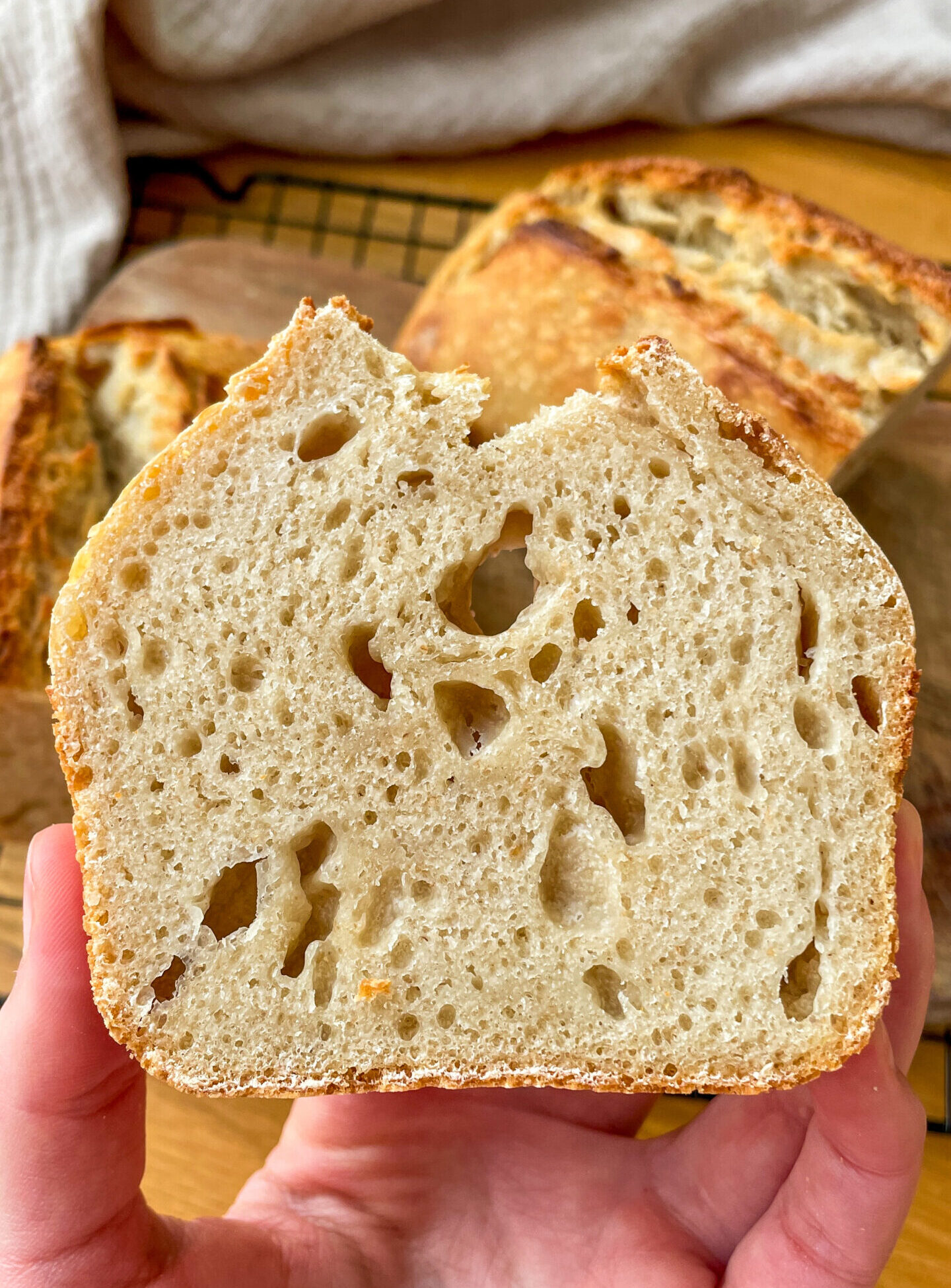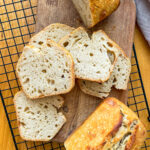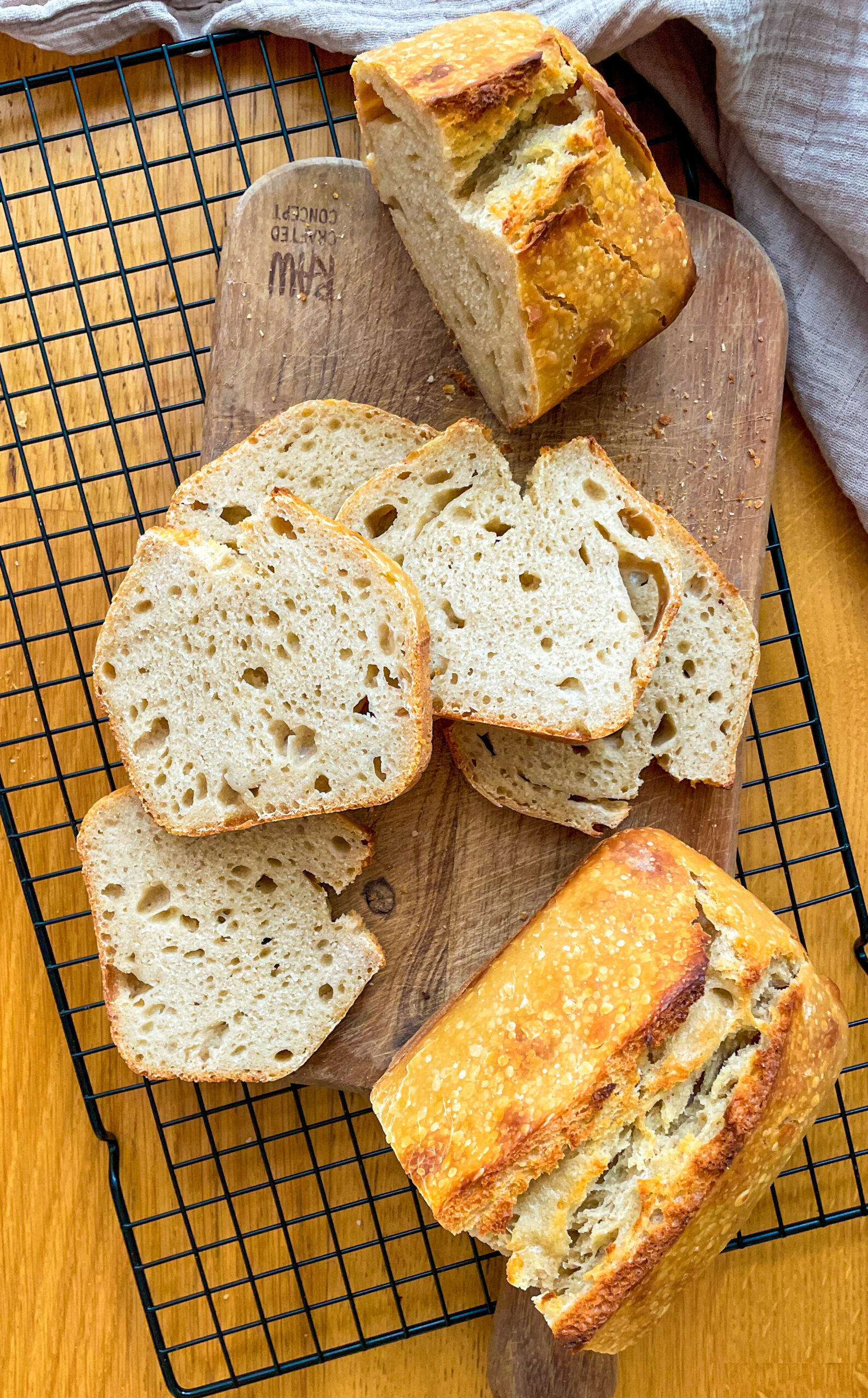There’s nothing quite like the smell of freshly baked sourdough bread filling your kitchen. After years of baking (and yes, lots of dense, flat loaves along the way!), I’ve finally perfected a sourdough recipe that delivers a crusty loaf with a soft, airy crumb every time.
Whether you’re just getting started or looking to refine your technique, I’ll walk you through every step!
Why Sourdough Bread Is Worth the Hype?
Sourdough bread has stood the test of time, not just for its unique taste and texture but also for its potential health benefits. Unlike conventional bread made with baker’s yeast, sourdough uses a natural fermentation process involving wild yeast and lactic acid bacteria. It’s loaded with benefits that set it apart from regular bread:
- It’s naturally more nutritious: The fermentation process breaks down phytic acid, which can block your body from absorbing minerals like magnesium and zinc. This means sourdough helps you get more of the good stuff from your bread.
- Easier to digest: Thanks to its long fermentation, sourdough breaks down gluten more effectively than bread made with baker’s yeast. This makes it gentler on the stomach, especially for those with mild gluten sensitivities.
- Better for blood sugar: Sourdough has a lower glycemic index, meaning it digests more slowly and is less likely to cause spikes in blood sugar levels.
- The flavor is unbeatable: That tangy, slightly sour taste and the perfect mix of crusty and soft textures make sourdough a joy to eat.

Sourdough Loaf Ingredients
Here’s what you’ll need:
- Active sourdough starter: Make sure it’s active and bubbly. Your starter is your wild yeast.
- Water: just filtered water at room temperature.
- Olive Oil: Adds a touch softness.
- Flour: All purpose or bread flour works best.
- Honey: This helps soften the bread.
- Salt: Use any salt.
Tips for Success
- Give your starter time: Make sure your sourdough starter is bubbly and doubled in size before you begin. This ensures that your dough will rise beautifully.
- Go slow: Sourdough bread requires time and patience. Let the dough rest, rise, and work its magic.
- Temperature matters: If your kitchen is chilly, consider giving your dough a bit more time to rise. Warmth helps the fermentation process.

How To Make Sourdough Bread Loaf From Scratch
STEP 1: Feed Your Starter
The evening before you plan on making the bread, feed your sourdough starter. This will ensure that by the next morning, it’s bubbly and active, ready to be used in your bread.
Step 2: Make the Dough
In a large bowl, combine the water, sourdough starter, olive oil, and honey. Stir until everything is well mixed. Add the flour and salt, and mix until a sticky dough forms.
Step 3: Rest the Dough
Cover the dough with a damp towel and let it rest for about 30 minutes to 1 hour. This is when the dough absorbs the liquids, and it helps to make the dough easy to handle later.
Step 4: Stretch and Fold
After the dough has rested, it’s time for the stretch and fold technique. Wet your hands with a bit of water to prevent sticking, then gently pull one side of the dough and fold it over onto the other side. Rotate the dough and repeat this for about 8-10 folds.
Cover the dough again with the damp towel and wait for 30 minutes. Then, repeat the process again. I usually do this about 3-5 rounds depending on the time I have. Sometimes I only do two rounds, and that works just fine. The idea is to build strength in the dough.
Step 5: Let the Dough Ferment
Once you’ve finished the last round of stretch and folds, cover your dough with plastic wrap. Let it ferment for 6-8 hours, depending on your room temperature. The dough should double in size during this time.
Step 6: Shape the Loaf
When the dough is ready, flour a clean surface and gently turn out your dough. To shape it, fold the left side of the dough over to the right, then the right side over to the left. After that, roll the dough from the bottom up until you have a nice, smooth loaf shape.
Grease a glass loaf pan with olive oil and place your shaped dough inside. Cover it with plastic wrap and let it rest at room temperature for 30 minutes to 1 hour. After that, put it in the fridge to proof overnight for 12 to 24 hours.
Step 7: Preheat and Bake
The next morning, take your loaf out of the fridge and let it sit on the counter while you preheat your oven. To bake, place your loaf in the oven and cover it with another loaf pan. This creates steam, which helps with the crust and prevents it from browning too quickly. Bake for 30 minutes with the cover on, then remove the top pan and continue baking for another 25 minutes, or until the loaf is golden.
Step 8: Cool and Slice
Once the bread is done, take it out of the oven and let it rest in the pan for about 15 minutes. After 15 minutes, remove the loaf from the pan and let it cool completely for 1-2 hours before cutting. This cooling time is important! Don’t slice it right away, it helps the bread set properly.
How to Store Sourdough Bread?
Once your bread is completely cool, slice it up and store it in an airtight container for 5-7 days. I like to freeze it in slices so that I can enjoy fresh bread anytime.


Beginner Sourdough Loaf
Ingredients
- 250 g (1 cup) water
- 150 g (⅔ cup) bubbly sourdough starter (active and doubled in size)
- 20 g (1 tbsp) olive oil
- 25 g (1 tbsp) honey
- 440 g (3½ cups) flour (all-purpose or bread flour works best)
- 10 g (2 tsp) salt
Instructions
-
Feed Your Starter: The evening before baking, feed your sourdough starter with equal parts water and flour. Let it sit at room temperature overnight to ensure it's active and bubbly.
-
Combine Wet Ingredients: In a large bowl, mix 250g water and 150g bubbly sourdough starter. Add 20g olive oil and 25g honey, stirring to combine.
-
Add Dry Ingredients: Add 440g flour and 10g salt to the mixture. Mix until the dough just comes together. Do not overmix.
-
Rest Dough: Cover the bowl with a damp towel and let the dough rest for 30 minutes to 1 hour to absorb the liquids.
-
Stretch and Fold: Wet your hands. Perform 8-10 stretch-and-fold motions (gently pulling one side of the dough and folding it over). Cover the bowl and let it rest for 30 minutes. Repeat this process for 3-5 rounds, depending on time.
-
Bulk Fermentation: After the final stretch-and-fold, cover the dough with plastic wrap and let it ferment at room temperature for 6-8 hours, or until it nearly doubles in size.
-
Shape the Dough: Turn the dough out onto a floured surface. Fold in the edges, then roll the dough from the bottom to form a tight loaf.
-
Prepare the Loaf Pan: Grease a glass loaf pan with olive oil. Transfer the shaped dough into the pan. Cover with plastic wrap and let rest at room temperature for 30 minutes to 1 hour. After that, put it in the fridge to proof overnight for 12 to 24 hours.
-
Bake the Bread: Preheat the oven to 210°C (410°F). Cover the loaf pan with another loaf pan to trap steam. Bake for 30 minutes. Remove the cover and bake for an additional 25 minutes, or until golden brown.
-
Cool and Slice: Let the bread cool in the pan for 15 minutes, then transfer it to a wire rack. Allow it to cool completely (1-2 hours) before slicing.
Recipe Notes
- Cooling the bread completely before slicing ensures the crumb sets properly.
- Freeze sliced bread for easy reheating later.
